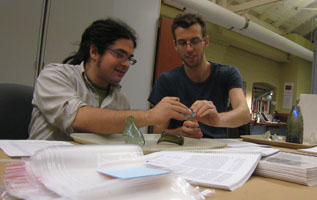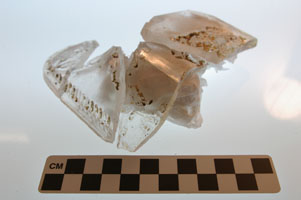Greetings from the historical archaeology lab at the Stanford Archaeology Center. In Summer 2008 two new Stanford graduate students, Guido Pezzarossi and Adrian Myers, worked with the assemblage of glass artifacts from the Market Street Chinatown collection. Our goal has been to get as much as possible cataloged and entered into the computer database. As we catalog we’re undertaking preliminary analysis: at the minimum describing the artifact and whenever possible the method of manufacture and other diagnostic attributes. After nearly completing the glass from Lot 85-31 (about 9 boxes), we’ve noted that the majority of glass artifacts can plausibly be related to alcohol consumption. We catalogued many “Champagne” and “Mineral” style bottle finishes, as well as many bottle bases with deep push-ups, all attributes that are usually (but not always) associated with wine and liquor bottles. However the assemblage certainly is diverse; along with the liquor bottles, we’ve seen medicine bottles, inkwells, lamp chimneys, tableware and decorative items. We’ve also come across a number of glass artifacts that we can’t identify, thus we’re including two “mystery artifacts” in today’s post. Have a look at the pictures and please let us know your thoughts. Post a comment below, or email the Project Director at bvoss@stanford.edu.
Featured Artifacts
Mystery Artifact #1: Single fragment of colorless glass, with iridescent patination. Weight: 47 grams. Manufacture method unknown, but no evidence of mould seams. Includes what appears to be the finish or spout from a bottle or jug, but could be something else. The finish is approximately 18 millimeters in diameter and the bore is approximately 8 millimeters in diameter. The bore of the finish is blocked by residue, possibly dirt or decayed cork (established as not metallic). The body glass is between 1 and 2 millimeters thick. Again, at first sight this would appear to be a fragment of an oddly shaped, bulbous, bottle. However, seemingly it could also be a fragment of a household or industrial furnishing such as lamp.
Mystery Artifact #2 Fragments of colorless glass, with iridescent patination. Combined weight: 194 grams. Manufactured by press molding. Fragments crossmend into what appears to be part of a decorative household furnishing, possibly a lamp base or sconce. Impressed with a grape vine pattern, with residue of gilding or paint in the crevices.


